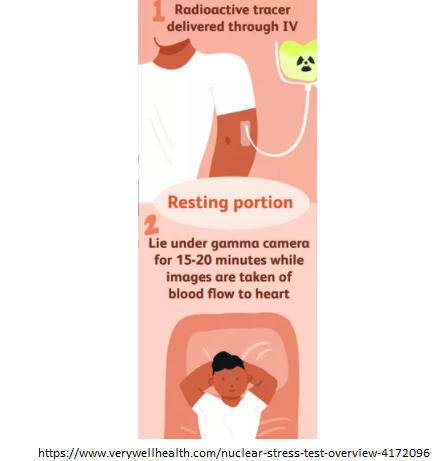
I did my nuclear perfusion stress test yesterday. This is to check how open your coronary arteries are, at rest and under stress. Here’s a quick overview:


It seems like this test would go quickly, but it took over two hours, because there’s a lot of waiting in between. First the tech for the stress test puts all your cardiac leads on, and inserts a shunt for the tracer. Then the tech for the gamma camera squirts in the tracer. Back out to the lobby and wait. Then you get the resting scan, top picture. Back out to the lobby and wait again. Then you do the treadmill part. I got more tracer squirted in while I was exercising at 129 bpm heart rate, then had to hold at that pace for a minute, then a short cooldown. Cardiac leads removed. Back out to the lobby and wait again. This is a more enjoyable wait, because you’re told to bring a high fat snack and now you get to eat it. For some reason the high fat helps flush out the remaining tracer. I brought bread and butter, nuts, and tortilla chips. There were a couple of other people cycling in and out of the waiting room and at some point we realized we were all going through the same test so also enjoyed talking to those two ladies. One of was quite looking forward to her snack as she’s been on a low fat diet for her heart. She said that egg salad sandwiches with mayo were what she missed most, and she was taking this opportunity to indulge in them. My higher fat choice seemed less fun in comparison. But eating still helped pass the time. Now I was called back in for the post-exercise gamma ray scan.
It was a little tedious with the waiting room interludes, but fortunately I have the Kindle app on my phone so had something to read. Now I just need to wait for the Doc about the results.
There was one thing about the test that was disappointing. This is tens of thousands of dollars of state of the art equipment. But they use the obsolete and inaccurate “220-age” formula to estimate your maximum heart rate, They take 85% of that to be the target heart rate which is the max the test takes you up to. For me that comes to 129 bpm. My actual max heart rate is 174, not 152 (220-age). So for me 129 is a pretty moderate pace. I mentioned this in advance to the test but he said they have to use the formula, which he called “the national average”. I don’t think it matters for the purpose of this test which is just to make sure my coronary arteries are open. Note: See my previous post about heart rate formulae, there’s an update. It turns out 220-age is the most conservative formula, so they may be sticking to it for safety.
It’s amusing that I had used this test as something I pointed my training towards !!, because I could easily have gone on a treadmill up until heart rate 129 without bothering to train. But it’s just as well, it gave me something to motivate me. 🙂
At some point in the future I’d like to see if we can do another stress test, which does allow me to go near my true max heart rate, just to make sure I don’t have any arrhythmias. I’ll bring this up with my Doc when I talk to him on June 30th.
More background on how the perfusion scan works, for nerds like me: Here’s a description from John’s Hopkins about how the tracer works: “The tracer travels through the bloodstream and is absorbed by the healthy heart muscle. On the scan, the areas where tracer has been absorbed look different from the areas that do not absorb it. Areas that are damaged or don’t have good blood flow do not absorb the tracer. The damaged areas may be called “cold spots” or “defects.” So since this is done both at rest and during vigorous exercise the cardiologist can compare the two results. Here’s an example of a comparison:

Published
June 18, 2021June 17, 2021



